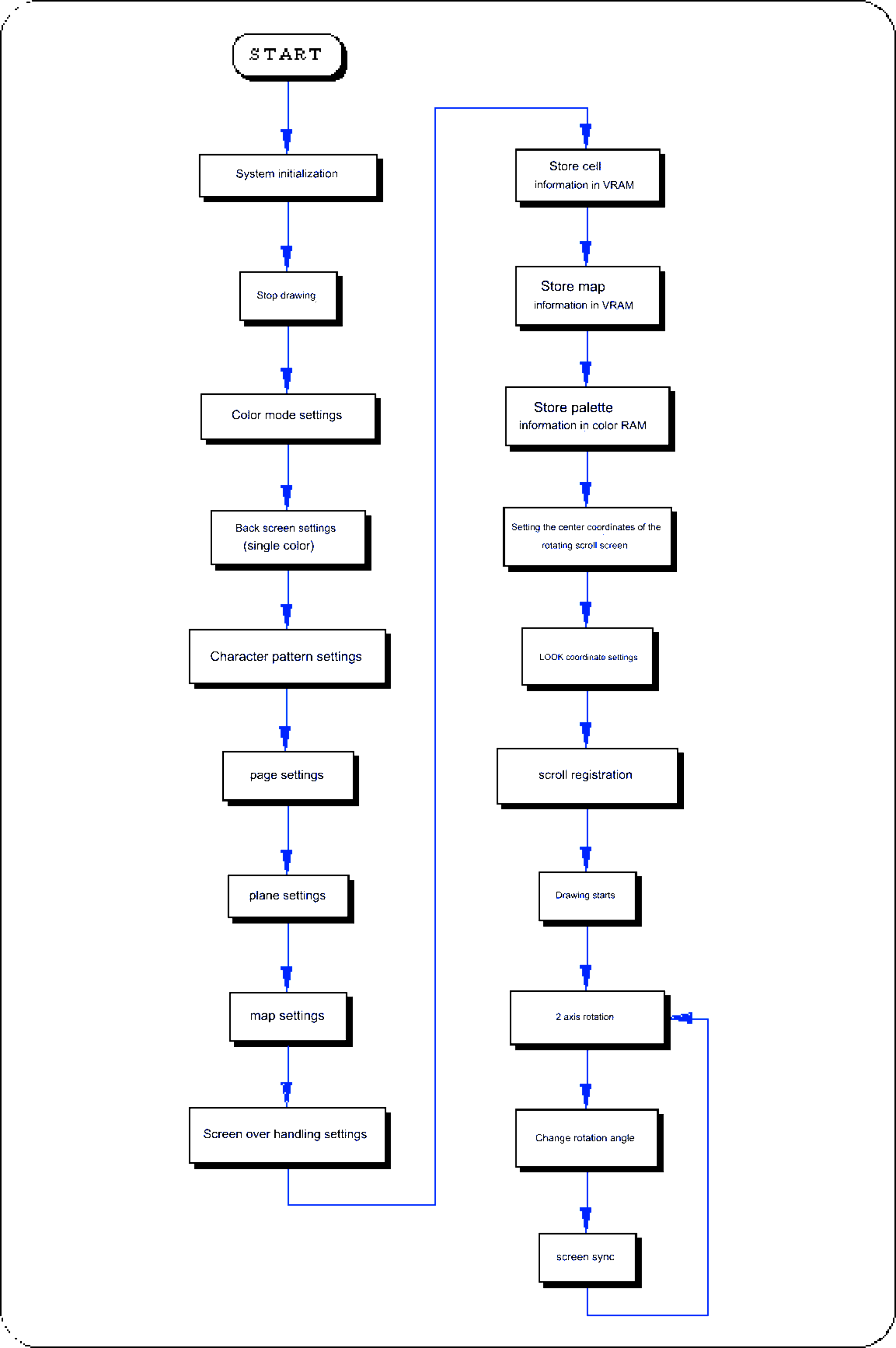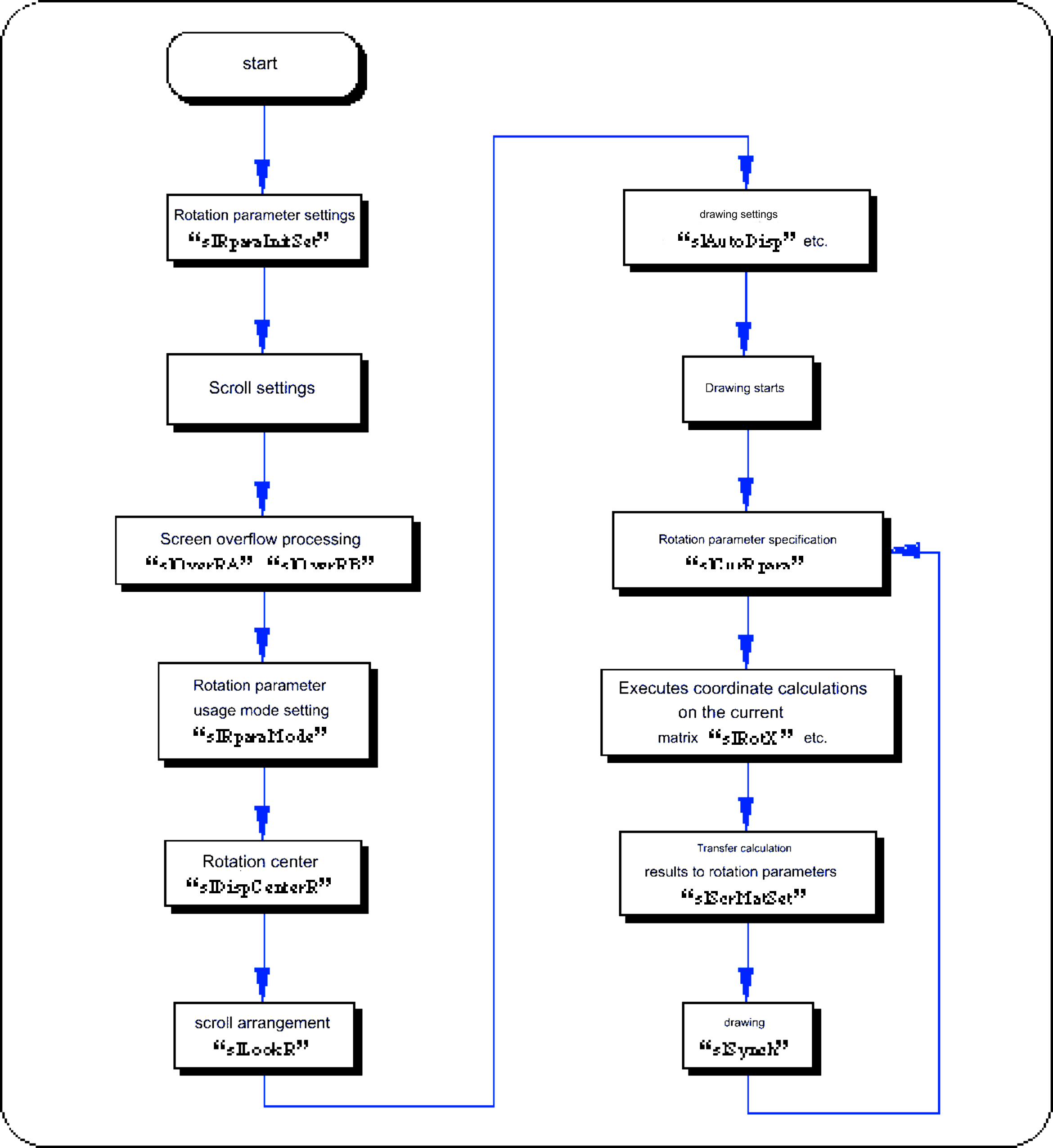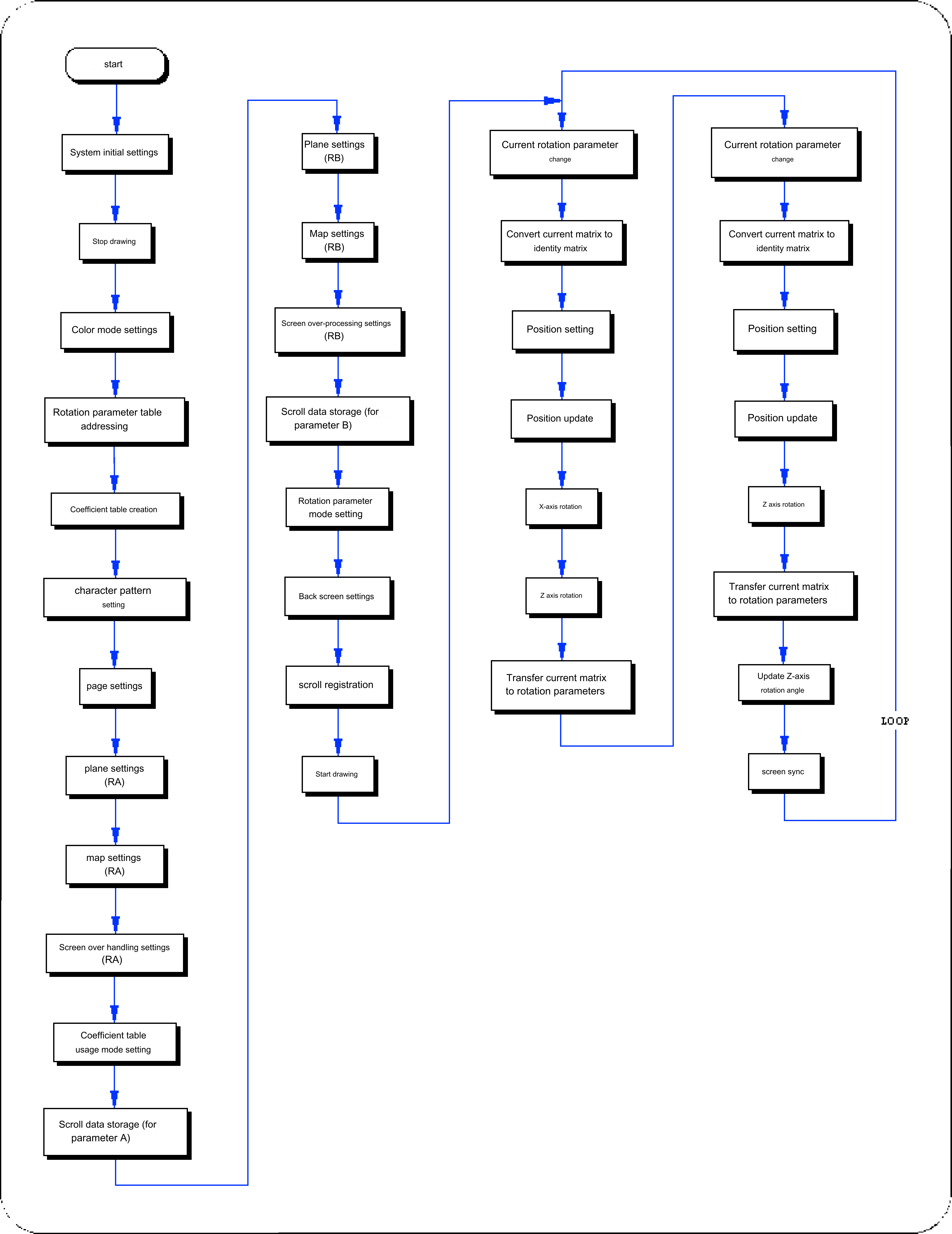8-9. Rotating scroll screen
Also, although the idea is different from normal scrolling, it is also possible to move the scroll vertically and horizontally.
Here, we will explain the movement, scaling, and rotation functions of the rotating scroll along with a sample program.
Moving the rotating scroll
By using the function "slLookR", you can make it appear as if the scroll is moving vertically, horizontally, and vertically relative to the monitor. Figure 8-21 Image of rotating scroll movement

Rotating scroll screen scaling
In addition, in the case of a rotating scroll screen, it can also be used in combination with the scroll rotation operation, enlargement/reduction operation, and movement operation described later.
If you want to scale the rotating scroll screen using SGL, please use the library function "slZoomR".
Assign the scroll vertical and horizontal magnification as reciprocal numbers to the parameters.
For example, if you want to enlarge it by 2 times, assign 1/2 to the parameter, and if you want to reduce it by 1/2, assign 2 to the parameter.
For rotary scrolling, scaling can always be set to any desired magnification.
Rotate scroll screen rotation
(The image below is an image model). Figure 8-22 Scroll rotation image

The point set by the library function "slDispCenterR" is used as the rotation center point (one point on the scroll map).
Specify the Z-axis rotation angle of the current rotation parameter in the parameter.
For the rotation angle, substitute the absolute rotation angle value, not the rotation angle value from the current state.
(The current parameter can be switched using the function “slCurRpara”).
Also, the point set by the library function “slLookR” is used as the center of rotation. Figure 8-23 Actual behavior of scroll rotation

This is because the function group described above rewrites a specific area of the rotation parameter, whereas the function group described later rewrites the entire rotation parameter.
The following sample program (Listing 8-5) is an example of actually rotating a rotating scroll screen using SGL library functions.
Listing 8-5 sample_8_9_1: 2D rotation of scroll
/*------------------------------------------------ ----------------------*/
/* Graphic Rotation */
/*------------------------------------------------ ----------------------*/
#include "sgl.h"
#include "ss_scroll.h"
#define RBG0_CEL_ADR VDP2_VRAM_A0
#define RBG0_MAP_ADR VDP2_VRAM_B0
#define RBG0_COL_ADR ( VDP2_COLRAM + 0x00200 )
#define RBG0_PAR_ADR ( VDP2_VRAM_A1 + 0x1fe00 )
#define BACK_COL_ADR ( VDP2_VRAM_A1 + 0x1fffe )
void ss_main(void)
{
ANGLE yama_angz = DEGtoANG(0.0);
FIXED posx = toFIXED(128.0) , posy = toFIXED(64.0);
slInitSystem(TV_320x224,NULL,1);
slTVOff();
slPrint("Sample program 8.9.1" , slLocate(9,2));
slColRAMMode(CRM16_1024);
slBack1ColSet((void *)BACK_COL_ADR , 0);
slRparaInitSet((void *)RBG0_PAR_ADR);
slCharRbg0(COL_TYPE_256 , CHAR_SIZE_1x1);
slPageRbg0((void *)RBG0_CEL_ADR , 0 , PNB_1WORD|CN_10BIT);
slPlaneRA(PL_SIZE_1x1);
sl1MapRA((void *)RBG0_MAP_ADR);
slOverRA(2);
Cel2VRAM(yama_cel , (void *)RBG0_CEL_ADR , 31808);
Map2VRAM(yama_map, (void *)RBG0_MAP_ADR, 32, 16, 1, 0);
Pal2CRAM(yama_pal , (void *)RBG0_COL_ADR , 256);
slDispCenterR(toFIXED(160.0) , toFIXED(112.0));
slLookR(toFIXED(128.0) , toFIXED(64.0));
slScrAutoDisp(NBG0ON | RBG0ON);
slTVOn();
while(1){
slZrotR(yama_angz);
yama_angz += DEGtoANG(1.0);
slSynch();
}
}
Flow 8-6 sample_8_9_1: 2D rotation of scroll

The same functions are used, such as “slRorX”, “slTranslate”, and “slScale”.
However, the order of rotation, movement, and scaling operations is the opposite of that of normal coordinate transformation operations (see "Chapter 4: Coordinate Transformation" for the order of transformation operations).
Also, the scroll coordinate system is a left-handed coordinate system because the positive and negative of the Z axis are reversed, but since the monitor rotates in response to scrolling, it looks exactly the same.
If you want to perform a coordinate conversion operation using the same matrix operation procedure as a normal coordinate conversion operation, please use the function “slScrMatConv” before transferring matrix data.
The function “slScrMatConv” converts the current matrix transformed using the normal coordinate transformation procedure into a coordinate transformation matrix for scrolling and makes it the current matrix.
Naturally, if you use this function on the current matrix after executing the scrolling coordinate transformation operation, the current matrix will be replaced with the normal coordinate transformation matrix.
Rotating scrolls are transformed and drawn based on the rotation parameter data that is transferred as a calculation result.
Use the function “slScrMatSet” to transfer data.
Please use it to transfer the current matrix that has been subjected to coordinate transformation operations according to rotational scrolling. Flow 8-7 Procedure for 3D rotation operation using current matrix

When using the coefficient table, the following two functions are required.
Be sure to create the coefficient table in VRAM.
Also, the coefficient table occupies one bank in the VRAM area. This is because the coefficient table references the VRAM area for the maximum number of accesses per bank (8 times).
Assign the start address of the area where the coefficient table will be created to the parameter.
Also, the coefficient table must be allocated in the VRAM area.
Assign the starting address of the coefficient table and the values shown in the figure below that indicate the coefficient table usage mode (can be used in conjunction with the or operator "|") to the parameters.
The function "slKtableRA" sets the coefficient table used by rotation parameter A, and the function "slKtableRB" sets the coefficient table used by rotation parameter B.
| Table usage: | [K_OFF | K_ON ]| |
| Coefficient data size: | [K_2WORD | K_1WORD]| |
| Coefficient mode: | [K_MODE0 | K_MODE1 | K_MODE2 | K_MODE3]| |
| Line color: | [K_LINECOL]| |
| Deformation unit: | [K_DOT | K_LINE ]| |
| Fixed coefficient: | [K_FIX ]| |
List 8-6 sample_8_9_2: 3D rotation
#include "sgl.h"
#include "ss_scroll.h"
#define RBG0RB_CEL_ADR (VDP2_VRAM_A0 )
#define RBG0RB_MAP_ADR (VDP2_VRAM_B0 )
#define RBG0RB_COL_ADR (VDP2_COLRAM + 0x00200)
#define RBG0RA_CEL_ADR (RBG0RB_CEL_ADR + 0x06e80)
#define RBG0RA_MAP_ADR (RBG0RB_MAP_ADR + 0x02000)
#define RBG0RA_COL_ADR (RBG0RB_COL_ADR + 0x00200)
#define RBG0_KTB_ADR (VDP2_VRAM_A1 )
#define RBG0_PRA_ADR (VDP2_VRAM_A1 + 0x1fe00)
#define RBG0_PRB_ADR (RBG0_PRA_ADR + 0x00080)
#define BACK_COL_ADR (VDP2_VRAM_A1 + 0x1fffe)
void ss_main(void)
{
FIXED posy = toFIXED(0.0);
ANGLE angz = DEGtoANG(0.0);
ANGLE angz_up = DEGtoANG(0.0);
slInitSystem(TV_320x224,NULL,1);
slTVOff();
slPrint("Sample program 8.9.2" , slLocate(9,2));
slColRAMMode(CRM16_1024);
slRparaInitSet((void *)RBG0_PRA_ADR);
slMakeKtable((void *)RBG0_KTB_ADR);
slCharRbg0(COL_TYPE_256 , CHAR_SIZE_1x1);
slPageRbg0((void *)RBG0RB_CEL_ADR , 0 , PNB_1WORD|CN_12BIT);
slPlaneRA(PL_SIZE_1x1);
sl1MapRA((void *)RBG0RA_MAP_ADR);
slOverRA(0);
slKtableRA((void *)RBG0_KTB_ADR , K_FIX | K_DOT | K_2WORD | K_ON);
Cel2VRAM(tuti_cel , (void *)RBG0RA_CEL_ADR , 65536);
Map2VRAM(tuti_map, (void *)RBG0RA_MAP_ADR, 64, 64, 2, 884);
Pal2CRAM(tuti_pal , (void *)RBG0RA_COL_ADR , 160);
slPlaneRB(PL_SIZE_1x1);
sl1MapRB((void *)RBG0RB_MAP_ADR);
slOverRB(0);
slKtableRB((void *)RBG0_KTB_ADR , K_FIX | K_DOT | K_2WORD | K_ON);
Cel2VRAM(sora_cel , (void *)RBG0RB_CEL_ADR , 28288);
Map2VRAM(sora_map, (void *)RBG0RB_MAP_ADR, 64, 20, 1, 0);
Pal2CRAM(sora_pal , (void *)RBG0RB_COL_ADR , 256);
slRparaMode(K_CHANGE);
slBack1ColSet((void *)BACK_COL_ADR , 0);
slScrAutoDisp(NBG0ON | RBG0ON);
slTVOn();
while(1)
{
slCurRpara(RA);
slUnitMatrix(CURRENT);
slTranslate(toFIXED(0.0) , toFIXED(0.0) + posy , toFIXED(100.0));
posy -= toFIXED(5.0);
slRotX(DEGtoANG(-90.0));
slRotZ(angz);
slScrMatSet();
slCurRpara(RB);
slUnitMatrix(CURRENT);
slTranslate(toFIXED(160.0) , toFIXED(155.0) , toFIXED(100.0));
slRotZ(angz);
slScrMatSet();
angz_up += DEGtoANG(0.5);
angz = (slSin(angz_up)>> Four);
slSynch();
}
}
Flow 8-8 sample_8_9_2: 3D rotation

 ★ SGL User's Manual ★ PROGRAMMER'S TUTORIAL
★ SGL User's Manual ★ PROGRAMMER'S TUTORIAL